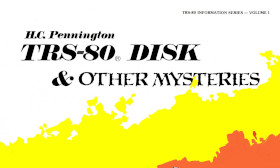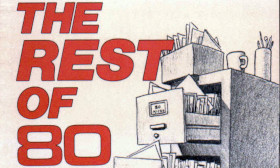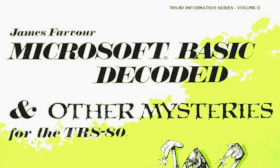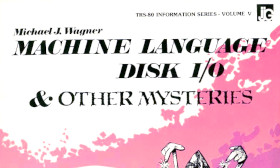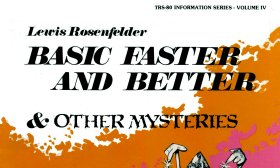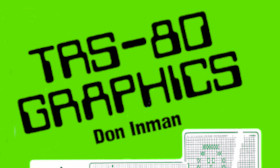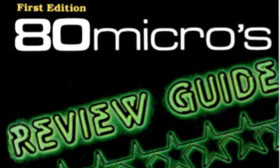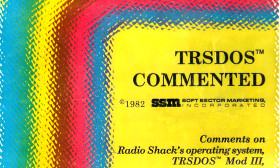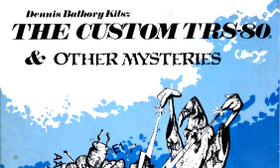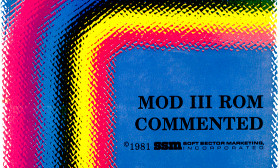Articles in the "Books" Category
One of the most popular books ever written for the TRS-80 was TRS-80 Disk and Other Mysteries by Harvard C. Pennington. It was published in 1979 by International Jewelry Guild of Upland, California (a company co-founded by Pennington) for a price of $22.95. The book was an unexpected success for International Jewelery Guild (better known as IJG), at the time primarily a seller of gold coins and diamonds. The first two printings of TRS-80 Disk and Other Mysteries sold out before IJG had even received them from the printers. One advertisement described the book as “the definitive work on the TRS-80 disk system.” The manual for Super Utility described it as “a ‘standard’ reference.”
The TRS-80 Model I was less than two years old at the time, and Pennington had been one of the first purchasers. There was a great demand for TRS-80 information and Pennington wrote about many topics in the TRS-80 Disk and Other Mysteries. These included using hexadecimal and binary, a discussion of TRS-80 disk operating systems, the TRSDOS directory structure, even Pennington’s opinions of Radio Shack. William Barden, Jr. described the contents in the preface to the book:
(Read more...)
In late 1982, 80 Micro magazine and the TRS-80 itself were riding a wave of popularity. Some issues of 80 Micro topped 500 pages and it was the third largest magazine in the United States, not just among computer magazines, but among all magazines. 80 Micro actively solicited articles and those enormous issues were filled largely with articles submitted by readers.
The book The Rest of 80 was another result of this abundance of material. It was a collection of articles submitted to 80 Micro, but never published. They were described as “some of the very best manuscripts ever sent to 80 Micro.” The Rest of 80 cost $9.97 when it was introduced in 1983.
(Read more...)
There were many books that documented and disassembled the TRS-80 Model I ROM, but Microsoft BASIC Decoded and Other Mysteries by James Lee Farvour was the most famous. Microsoft BASIC Decoded and Other Mysteries, volume 2 in the IJG’s TRS-80 Information Series, includes a complete overview of the Level II ROM in the TRS-80 Model I and is one of the best sources of information about the TRS-80 BASIC ROM. It cost $29.95 when it was introduced in 1981. A January 1982 review in 80 Micro said “Without a doubt, it is the most comprehensive book on Level II BASIC ROM to be published so far.”
Microsoft BASIC Decoded and Other Mysteries is made up of two sections. The first half of the book collect a wide assortment of details about BASIC, including some not commonly found elsewhere. This includes information such as reserved BASIC keywords, functions and entry points, the format used for cassette storage, even the formulas used by the BASIC math functions such as SIN and COS. One chapter covers disk operating systems, which weren’t even part of Microsoft BASIC.
(Read more...)
Low-level floppy disk access was one of the most advanced programming topics on the TRS-80 Model I and III. The floppy disk controller was documented in technical reference manuals, as was the TRS-80 disk interface itself. But translating that information into reliable disk access routines wasn’t easy. All disk operating systems and low-level disk utilities did it, but the difference between working and excellent implementations was great. Kim Watt (with Super Utility) and Vernon Hester (with MULTIDOS) proved that it was possible to write fast and bullet-proof disk routines, but the methods they used weren’t documented anywhere.
Machine Language Disk I/O and Other Mysteries by Michael J. Wagner, volume 5 in IJG’s TRS-80 Information Series, was one of the few sources of reliable information about low-level TRS-80 floppy disk access. It cost $29.95 when it was released in 1982. A 1983 review by John B. Harrell, III in 80 Micro described it as an “expertly assembled, compact, and fact-filled book” and “a perfect reference source for any programmer who would like to try his hand at disk I/O programming.”
(Read more...)
BASIC Faster and Better and Other Mysteries, also known as BASIC Faster and Better, is one of the best books about advanced BASIC programming on the TRS-80. It was written by Lewis Rosenfelder and published by IJG, Inc.
The book, which was volume 4 in IJG’s TRS-80 Information Series, cost $29.95 when it was introduced in 1981. Radio Shack also sold it as BASIC Faster and Better (catalog number 62-1002) for the same price, describing it in their catalog as “a guided tour of advanced BASIC programming.” A review in 80 Microcomputing stated:
The book is worth the money no matter what level of programming ability you possess.
(Read more...)
Introduction to TRS-80 Graphics (catalog number 62-2063), also known as TRS-80 Graphics, was a book describing how to make best use of the block graphics of the TRS-80 Model I. It was written by Don Inman and cost $5.95 from Radio Shack. Like many of the books sold by Radio Shack, there were two editions of the book with two different covers: one was sold by Radio Shack and the other was sold by dilithium Press. (The name dilithium was intentionally lowercase.) Other than the covers, the books were identical.
The focus of Introduction to TRS-80 Graphics was entirely on “understanding the graphics capabilities of the TRS-80 computer using Level I BASIC.” As the book stated: “No attempt is made to teach programming in BASIC.” A dilithium Press advertisement described it this way:
For those who want to do more with graphics, this excellent self-instruction text provides a complete introduction to the basics of graphics programming using dozens of examples.
(Read more...)
80 Micro (originally 80 Microcomputing) was the most popular of the TRS-80 magazines. The book 80 Micro’s Review Guide collected over 500 reviews that were published in 80 Micro during its first three years (1980 to 1983). The reviews (which were abridged) were divided into three broad categories: software, hardware, and books. They were further divided into 27 finer categories, such as word processor, disk drives, and modems.
The back cover stated:
The reviews are taken from the pages of 80 Micro magazine, the leading source of information in the TRS-80 world. Authors include some of the most knowledgeable people in microcomputing, including William Barden, Dan Robinson, Dennis Báthory-Kitsz, Terry Kepner, and Jake Commander.
(Read more...)
There were many popular books published back in the late 1970’s and early 1980’s that examined the TRS-80 Model I in detail. But there were far fewer books that served the same purpose for the TRS-80 Model III.
TRSDOS Commented, published by Soft Sector Marketing with “decoding and data entry” by Rick Papo, was one of those few. The book’s cover described it as “a must for every Mod III owner.” It included a complete disassembly for the code comprising Model III TRSDOS (minus Disk BASIC) in much the same way as the IJG book TRSDOS 2.3 Decoded and Other Mysteries did for Model I TRSDOS. One notable difference was that the disassembled listings in TRSDOS 2.3 Decoded and Other Mysteries were published with full permission from Tandy Corporation. Soft Sector Marketing had no such permission and included this disclaimer at the beginning of TRSDOS Commented:
(Read more...)
The Custom TRS-80 and Other Mysteries is one of the best remembered TRS-80 books. It was written by Dennis Báthory-Kitsz and published by IJG, Inc (also known as the International Jewelry Guild). The first printing sold out in less than a month and the book ended up selling 50,000 copies around the world in three printings. The Custom TRS-80 and Other Mysteries (which was volume 3 in IJG’s TRS-80 Information Series) offers an interesting and entertaining look at the hardware and software inside the TRS-80 Model I, the custom TRS-80 of the title.
Dennis Báthory-Kitsz was well known for his TRS-80 writing, including his articles in The Alternate Source and his 80 Applications column in 80 Microcomputing. (Some of the information in The Custom TRS-80 and Other Mysteries had previously appeared in his Alternate Source articles.)
(Read more...)
There were many books written that described and in some cases disassembled the TRS-80 Model I BASIC ROM. A few of the more famous examples were Microsoft BASIC Decoded and Other Mysteries from IJG, Inc., The B00K from Insiders Software Consultants, Pathways Through the ROM from SoftSide Publications, and Level II ROMs from Tab Books. But there were far fewer books serving the same purpose for the TRS-80 Model III BASIC ROM.
One of the best sources of information about the Model III ROM was TRS‑80 ROM Routines Documented by Jack Decker, which was published in 1983. But probably the best known was MOD III ROM Commented from Soft Sector Marketing. MOD III ROM Commented was published in 1981 with two printings. It contains a very detailed disassembly of the Model III BASIC ROM. As the book cover promised: “Not a rehash of old information, but an explanation of ROMS in the latest machine from Tandy.”
(Read more...)
The TRS-80 Applications Software Sourcebook, also known as the Applications Sourcebook, was a book containing short descriptions and information about third-party application software for the TRS-80. It was published by Radio Shack with at least eight volumes from 1980 to 1987.
Any publisher could buy a listing in the TRS-80 Applications Software Sourcebook. A listing cost $10.00 and included the name of the program, the price, a short description, TRS-80 compatibility information, and ordering details. A listing could only mention one program and there were no discounts for multiple listings.
Radio Shack first announced the TRS-80 Applications Software Sourcebook in the March/April 1980 issue of the TRS-80 Microcomputer News:
(Read more...)
BASIC Computer Games (ISBN 0-89480-052-3) was the first and most popular of a category of books containing games written in BASIC for typing into a computer. It was also the first computer book to sell more than a million copies. Many people took their first steps as programmers by typing in and modifying the programs in this book.
BASIC Computer Games and its sequel, More BASIC Computer Games (also known as BASIC Computer Games Volume II) were created by David Ahl, the founder and publisher of Creative Computing magazine. Both books were very popular and were translated into German (BASIC Computer Spiele and BASIC Computer Spiele: Band 2), French (Jeux D’Ordinateur en BASIC and Nouveaux Jeux D’Ordinateur en BASIC), and a three-volume Danish edition (BASIC Computerspil). Both BASIC Computer Games and More BASIC Computer Games had TRS-80 specific editions that were sold both by Radio Shack and Creative Computing Press.
(Read more...)
There were many excellent books written for people who wanted to learn about TRS-80 Model I assembly language programming, such as TRS-80 Assembly Language Programming by William Barden or Programming the Z80 by Rodnay Zaks. But my favorite book was a less famous one called TRS-80 Assembly Language Made Simple by Earles L. McCaul. I think TRS-80 Assembly Language Made Simple was the best book for teaching not just the specifics of assembly language, but also the mindset for effective assembly language programming.
According to an account by Earles L. McCaul, TRS-80 Assembly Language Made Simple came about through his work as an instructor at Arizona Western College in Yuma, Arizona. At the time, Arizona Western College offered only two microcomputer programming courses: one for BASIC and another for Intel 8080 machine language. He proposed creating an “intermediary” course that dealt with programming in assembly language for the TRS-80. His proposal was accepted by the college on the condition that he find an appropriate textbook for the course.
(Read more...)
When most people think of the Radio Shack TRS-80, they probably think of the TRS-80 Model I, III, and 4. But Radio Shack also sold another computer line, the TRS-80 Color Computer.
CoCo: The Colorful History of Tandy’s Underdog Computer by Boisy Pitre and Bill Loguidice explores the somewhat forgotten history of the Color Computer line. It tells the story of the Radio Shack Color Computer (fondly nicknamed the CoCo), starting with its development and introduction in 1980. It also contains additional information that helps to put the Color Computer within the broader context of computers at the time, including a chapter about the popular RAINBOW magazine for Color Computer users. The book doesn’t end when Radio Shack discontinued the Color Computer 3 in 1990; it continues with more stories about the companies and people who still supported the Color Computer after the “official” end.
(Read more...)
The TRS-80 Computer Whiz Kids (later renamed The Tandy Computer Whiz Kids) was a comic book series that was created by the Radio Shack Education Comic Book Program. The series consisted of eleven issues, running from 1980 to 1992, which were distributed for free to schools. Any teacher (writing on school letterhead) could request a free packet of fifty comic books from Radio Shack.
The comic books focused on classmates Alec and Shanna and their teacher, Ms. Wilson. Alec and Shanna were the so-called TRS-80 Computer Whiz Kids. Ms. Wilson, her students, and the many visitors to the classroom all made frequent use of many different Radio Shack products.
(Read more...)
Alien Defense Commented is an unusual book that contains the complete source code listing for the Soft Sector Marketing game Alien Defense (which was still being sold at the time the book was published). It was written by Larry Ashmun, the author of Alien Defense, and was intended for programmers looking for “details of one approach to game writing.” As the advertisements promised:
Never Before Has Anyone Sold a Book Like This!
If you write in machine language; if you have thought of writing a machine language game; if you ever just wondered what a machine language program looked like in its uncompiled form – this is your book!
(Read more...)
The
TRS-80 Micro Computer Technical Reference Handbook (catalog number 26–2103), more commonly called the
TRS-80 Technical Reference Handbook (even in the Radio Shack catalog), was the official technical reference manual for the TRS-80 Model I. The first edition, which cost $9.95, was printed in 1978. A second edition, revised to reflect later updates to the Model I, was printed in 1982 (one year after the Model I was discontinued).'
(Read more...)
Adventure games were some of the earliest games written for computers and they were incredibly popular at the beginning of the microcomputer revolution. Despite this popularity, there were only a handful of books that showed how adventure games worked in detail or how to write one. In my opinion, the best book of this type was Writing BASIC Adventure Programs for the TRS-80 by Frank DaCosta. Published in 1982 by TAB Books, Writing BASIC Adventure Programs for the TRS-80 describes two different types of adventure games, with full listings that the reader could type in to the computer. (Both programs were also available through the mail from the author for $19.95 on either disk or tape.)
DaCosta devotes the main part of the book (the first ten chapters) to Basements and Beasties, a classic text adventure in the mold of William Crowther’s original Adventure. After describing how an adventure game works in general, DaCosta lays out the framework needed for a text adventure.
(Read more...)
In the early days of microcomputers, books containing “type-in” BASIC programs were common. But probably the book series published for the widest range of computers was the “32 BASIC Programs” series, written by Tom Rugg and Phil Feldman and published by dilithium Press. (The name dilithium was intentionally lowercase.)
Each book contained thirty-two BASIC programs divided into six categories: applications, educational, graphics, game, mathematics, and miscellaneous. Some of the later books added seven extra programs spread across the same categories.
The text of each book was almost identical, sometimes with just the name of the computer changed. Of course, the programs themselves and the screenshots illustrating each program were necessarily different for each new computer.
The TRS-80 entry in the series was titled TRS-80 Programs: 32 BASIC Programs for the TRS-80 (Level II) Computer. Judging by the publication dates, it was the second book in the series, immediately following the Commodore PET version.
(Read more...)
Creative Computing was one of the longest running of the early microcomputer magazines, publishing from 1974 to 1985. Unlike most later microcomputer magazines, Creative Computing covered the entire range of personal computers, including the TRS-80, Atari, and Apple.
In 1983, Creative Computing Press published three books collecting computer-specific articles from the pages of Creative Computing. They targeted each book at a different computer market: The Creative Atari, The Creative Apple, and The Creative TRS-80.
The Creative TRS-80, edited by Ken Mazur with a preface by Creative Computing Associate Editor John J. Anderson, has over 100 articles and reviews from Creative Computing.
(Read more...)
Understanding how to use TRS-80 ROM routines was very important for any TRS-80 Model I or III programmer, and there were many books written about that subject. TRS-80 ROM Routines Documented by Jack Decker was considered to be one of the best. Jack Decker wrote many articles for The Alternate Source, including a series named “TRS-80 ROM Routines Documented,” which served as the basis for this book.
The bulk of TRS-80 ROM Routines Documented is composed of five chapters detailing various portion of the TRS-80 ROM:
(Read more...)
At one time in the TRS-80 world, the name William Barden was linked to assembly language programming. This book was one of the main reasons why.
TRS-80 Assembly Language Programming, along with
Programming the Z80 by Rodney Zaks, helped introduce a whole generation of TRS-80 programmers to assembly language.
(Read more...)
The history of early microcomputers is a poorly documented subject and the amount of misinformation available is incredible. That’s why it is such a pleasure to read a book by someone knowledgeable about the subject. Collectible Microcomputers_ is just that book, a reference book for classic computers.
Long-time TRS-80 users may remember Michael Nadeau as a frequent contributor to 80 Micro, serving as senior copy editor, executive editor, and later editor-in-chief. He was also editor-in-chief of HOT CoCo magazine and the coordinator of the 80 Micro Anniversary issue.
(Read more...)
TRSDOS 2.3 Decoded and Other Mysteries was written by James Lee Farvour and published by IJG in 1982. It was volume six in the TRS-80 Information Series.
In a way, this book was a companion to James Lee Farvour’s earlier Microsoft Basic Decoded and Other Mysteries. That book analyzed TRS-80 Model I BASIC in great detail, describing how each part of the language worked. At the end of the book, it included the commented portion of a disassembly of the BASIC. It did not include the complete disassembly because Microsoft never gave permission for that to be published.
(Read more...)
Back in 1981, the TRS-80 was the best selling computer and
80 Microcomputing magazine was bursting at the seams. Wayne Green, the publisher of
80 Microcomputing, envisioned a new set of books: the
Encyclopedia for the TRS-80. As the first advertisement for the
Encyclopedia stated:
(Read more...)
Lately, there seems to be an increasing interest in the history of early microcomputers. But for whatever reason, Radio Shack and the TRS-80 are rarely mentioned in histories of microcomputing. When the TRS-80 is mentioned, the details are often incomplete or completely wrong. I don’t know what has caused this collective amnesia, but the TRS-80 deserves to have its important contributions recognized.
(Read more...)
The Programmer’s Guide is my favorite TRS-80 programming book, and in my opinion, the most useful. The chapters include:
- an overview of the operating system
- device input/output, with information about filters and drivers
- disk drive input/output, with information about writing a disk driver
- DOS directory structure
- disk file access and control
- interfacing with supervisory calls (SVCs), including detailed information about parameters
- other useful miscellaneous tables and topics
(Read more...)
Even though
Programming the Z80 was not written for the TRS-80, it was one of the more popular TRS-80 programming books. I suspect that this book and
TRS-80 Assembly Language Programming by William Barden introduced more TRS-80 programmers to assembly language than any others.
(Read more...)
The Source was a three volume set containing the complete source code of TRSDOS 6.2 (which was the same as LS-DOS 6.2). Each individual book cost $99.00, so total cost for a complete set was $297.00. Later on, these prices were heavily discounted.
(Read more...)
